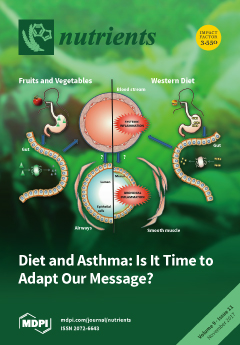1
Artificial Nutrition Unit Bambino Gesù, Children’s Hospital, IRCCS, 00165 Rome, Italy
2
Gastroenterology Unit, G. Gaslini Institute for Maternal and Child Health, IRCCS, 16145 Genova, Italy
3
Department of Pediatrics, “Burlo Garofolo” Hospital, University of Trieste, IRCCS, 34137 Trieste, Italy
4
Division of Nutrition, Regina Margherita Children’s Hospital, 10126 Turin, Italy
5
Department of Gastroenterology and Nutrition Unit, Meyer Children’s Hospital, 50139 Florence, Italy
6
Department of Transalational Medical Science, Section of Pediatrics, University of Naples Federico II, 80138 Naples, Italy
7
Department of Paediatrics, Università Politecnica delle Marche, 60121 Ancona, Italy
8
Paediatric, Hepatology, Gastroenterology and Transplantation, Hospital Papa Giovanni XXIII, 24127 Bergamo, Italy
9
Department of Women’s and Children’s Health, University of Padua, 35122 Padua, Italy
10
Department of Clinical Science and Community Health, Neonatal Intensive Care Unit, Fondazione IRCSS Cà Granda Ospedale Maggiore Policlinico, University of Milan, 20122 Milan, Italy
11
Pediatrics Unit, Department of Women’s and Children’s Health, IRCCS Arcispedale Santa Maria Nuova, 42123 Reggio Emilia, Italy
12
Department of Biomedical Science and Human Oncology, Section of Neonatology and NICU, University of Bari, 70121 Bari, Italy
13
Department for the Treatment and Study of Pediatric Abdominal Diseases and Abdominal Transplantation, IRCCS ISMETT, 90127 Palermo, Italy
14
Department of Pathology, Bambino Gesù Children’s Hospital, IRCCS, 00165 Rome, Italy
15
Unit of Pediatrics, University of Foggia, 71122 Foggia, Italy
16
Pediatric Gastroenterology, Hepatology and Digestive Endoscopic Unit, University Hospital Umberto I, 00185 Rome, Italy
17
Unit of Pediatrics, Department of Human Pathology in Adulthood and Childhood “G. Barresi”, University of Messina, 98122 Messina, Italy
18
Hepatology and Gastroenterology Unit, Bambino Gesù Children’s Hospital, IRCCS, 00165 Rome, Italy
19
Santobono-Pausillipon” Children’s Hospital, 80138 Naples, Italy
20
Department of Medical and Surgical Neonatology, Bambino Gesù Children’s Hospital, 00165 Rome, Italy
21
Digestive Endoscopy and Surgery Unit, Bambino Gesù Children’s Hospital, IRCCS, 00165 Rome, Italy
22
Department of Pediatric Surgery, “Spedali Civili” Children’s Hospital, 25123 Brescia, Italy
23
Pediatric Surgery Unit, Women’s and Children’s Health Department, University of Padua, 35122 Padua, Italy
24
Department of Pediatric Surgery, S. Orsola Malpighi Polyclinic, 40138 Bologna, Italy
25
Department of Abdominal Transplantation and Hepatobiliary and Pancreatic Surgery, Bambino Gesù Children’s Hospital, IRCCS, 00165 Rome, Italy
add
Show full affiliation list
remove
Hide full affiliation list






